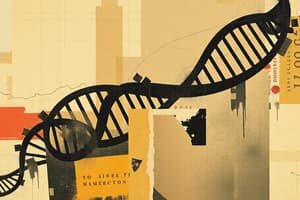Podcast
Questions and Answers
Which of the following is the primary function of proteins within a cell?
Which of the following is the primary function of proteins within a cell?
- Synthesizing lipids
- Catalyzing reactions, providing structure, and transporting molecules (correct)
- Generating cellular energy
- Storing genetic information
Transcription is the process where ribosomes build a protein based on the mRNA code.
Transcription is the process where ribosomes build a protein based on the mRNA code.
False (B)
In eukaryotic cells, where does the process of transcription primarily occur?
In eukaryotic cells, where does the process of transcription primarily occur?
nucleus
During translation, __________ molecules are responsible for carrying amino acids to the ribosome.
During translation, __________ molecules are responsible for carrying amino acids to the ribosome.
Match the following molecules with their roles in protein synthesis:
Match the following molecules with their roles in protein synthesis:
Which enzyme is responsible for synthesizing mRNA during transcription?
Which enzyme is responsible for synthesizing mRNA during transcription?
Codons are sequences of three nucleotides on tRNA that pair with mRNA.
Codons are sequences of three nucleotides on tRNA that pair with mRNA.
What type of bond is formed between amino acids during translation?
What type of bond is formed between amino acids during translation?
The start codon, typically __________, codes for the amino acid methionine.
The start codon, typically __________, codes for the amino acid methionine.
Match each process to its location in a eukaryotic cell:
Match each process to its location in a eukaryotic cell:
What is the role of a stop codon in translation?
What is the role of a stop codon in translation?
Ribosomes are composed solely of protein.
Ribosomes are composed solely of protein.
What is the name given to the sequence of three nucleotides on tRNA that recognizes mRNA codons?
What is the name given to the sequence of three nucleotides on tRNA that recognizes mRNA codons?
__________ is the process by which mRNA is created from a DNA template.
__________ is the process by which mRNA is created from a DNA template.
Match the following molecules to their composition:
Match the following molecules to their composition:
After translation, what may occur to a protein before it becomes fully functional?
After translation, what may occur to a protein before it becomes fully functional?
Each codon on mRNA codes for only one specific amino acid.
Each codon on mRNA codes for only one specific amino acid.
What is the final product of the translation process?
What is the final product of the translation process?
The process of protein synthesis is crucial for creating proteins that serve various roles, including __________, structural support, and enzymatic activity.
The process of protein synthesis is crucial for creating proteins that serve various roles, including __________, structural support, and enzymatic activity.
Match the following processes with their description:
Match the following processes with their description:
Flashcards
Protein Synthesis
Protein Synthesis
The process of creating proteins from the genetic code in DNA.
DNA's Role
DNA's Role
Molecule containing the genetic code for proteins, residing in the nucleus.
RNA's Role
RNA's Role
Involved in transferring information from DNA to ribosomes.
Transcription
Transcription
Signup and view all the flashcards
RNA Polymerase
RNA Polymerase
Signup and view all the flashcards
mRNA
mRNA
Signup and view all the flashcards
Ribosome
Ribosome
Signup and view all the flashcards
rRNA
rRNA
Signup and view all the flashcards
Translation
Translation
Signup and view all the flashcards
tRNA
tRNA
Signup and view all the flashcards
Amino Acids
Amino Acids
Signup and view all the flashcards
Codon
Codon
Signup and view all the flashcards
Anticodon
Anticodon
Signup and view all the flashcards
Peptide Bond
Peptide Bond
Signup and view all the flashcards
Stop Codon
Stop Codon
Signup and view all the flashcards
Study Notes
Protein Synthesis Overview
- Protein synthesis creates proteins based on DNA's genetic information.
- Proteins serve essential functions like transport, structure, enzyme activity, and protection.
- Protein synthesis takes place in cells.
Role of DNA and RNA
- DNA houses the genetic code for proteins and resides in the nucleus.
- RNA is essential for transferring DNA information to protein-making machinery.
- RNA, a nucleic acid, shares similarities with DNA but has key differences.
- Protein synthesis occurs in two main steps: transcription and translation.
Transcription
- Transcription, the initial step, involves transcribing DNA into mRNA.
- This occurs within the nucleus.
- RNA polymerase, an enzyme, links complementary RNA bases to DNA, forming single-stranded mRNA.
- mRNA undergoes editing before leaving the nucleus.
- mRNA carries a message of RNA based on the DNA sequence.
mRNA and Ribosomes
- In eukaryotes, mRNA can exit the nucleus and enter the cytoplasm.
- Inside the cytoplasm, mRNA binds to a ribosome.
- Ribosomes are responsible for protein synthesis.
- Ribosomes are composed of ribosomal RNA (rRNA).
Translation
- Translation, the second step, involves ribosomes building proteins based on the mRNA code.
- Transfer RNA (tRNA) in the cytoplasm carries amino acids.
- Amino acids are the building blocks (monomers) of proteins.
- tRNA transports amino acids to the ribosome for protein construction.
- The mRNA sequence determines which tRNAs enter, dictating the amino acid sequence.
Codons, Anticodons, and Amino Acids
- Transfer RNA (tRNA) reads mRNA bases in triplets called codons.
- Each tRNA has a complementary anticodon that pairs with the mRNA codon.
- Each tRNA carries a specific amino acid determined by its anticodon.
- For instance, the AUG codon on mRNA pairs with the UAC anticodon on tRNA, carrying methionine.
- Methionine often serves as the starting amino acid in a protein (start codon).
- Codon charts aid in determining which amino acid corresponds to each mRNA codon.
- Multiple codons can code for the same amino acid.
The Process of Translation
- The tRNA with the correct anticodon pairs with the mRNA codon and transfers its amino acid.
- Amino acids are connected via peptide bonds, forming a growing polypeptide chain.
- A stop codon at the end of the mRNA signals the termination of protein synthesis.
- Stop codons do not code for an amino acid.
- Translation produces a chain of amino acids in a specific sequence dictated by the mRNA.
Post-Translational Processing
- DNA directs protein synthesis with assistance from mRNA, rRNA, and tRNA.
- Protein folding and modification may occur post-translation.
- The protein may require transport to its final destination.
Studying That Suits You
Use AI to generate personalized quizzes and flashcards to suit your learning preferences.




